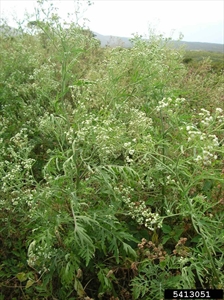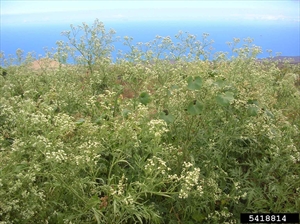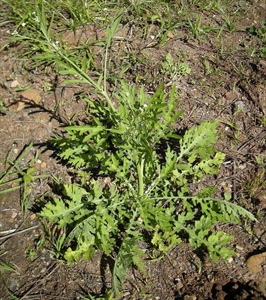- Worldwide distribution. In Australia, French Polynesia, New Caledonia, Papua New Guinea, Vanuatu.
- An aggressive weed flowering early, easily spread, and tolerant to drought. Forms dense stands in disturbed semi-arid environments: roadsides, riverbanks, railway lines, streams, wasteland, agricultural land (many crops, orchards plantations), natural grasslands, pastures. Chemicals from parthenium effect natural biodiversity, carrying capacity of pastures, quality of milk and meat, health of livestock.
- Stems up to 2m, becoming woody, branching, hairy. Leaves alternate up to 30cm, deeply divided, undersides hairy, forming rosette when young. Flowers in clusters from axils and terminal, white, on stalks. Individual flowers arranged in five ray (female) and tiny disc (male) florets. Fruits with five seeds with appendages.
- Spread: seed on the wind, in water; attached to animals, clothing, machinery, vehicles; movement of fodder, soil, sand, gravel.
- Biosecurity: high risk of introduction. In Australia, 'restricted invasive plant': do not release into environment, give away or sell.
- Biocontrol: moth, Pareuchaetes pseudoinsulata; stem-galling fly, Cecidochares connexa.
- Cultural control: pull-out wearing gloves (include basal bulb); plant competitive species leucaena, Tephrosia or ground cover legumes. Clean machinery/vehicles, check clothing, do not move contaminated soil, quarantine livestock 1 week between infested and ‘clean’ pastures.
- Chemical control: in Australia, picloram; fluroxypyr; glyphosate; triclopyr + picloram; triclopyr, picloram + aminopyralid; metsulfuron-methyl; fluroxypyr + aminopyralid. Use on regrowth after slashing.
Pacific Pests, Pathogens and Weeds - Online edition
Pacific Pests, Pathogens, Weeds & Pesticides
Parthenium (503)
Parthenium. It is also known as bittersweet, broomweed, false ragweed, wild wormwood, parthenium weed.
Parthenium hysterophorus. It is a member of the Asteraceae.
AUTHOR Grahame Jackson
Information from PIER (2017) Parthenium hysterophorus L., Asteraceae. Pacific Island Ecosystems at Risk (PIER), Institute of Pacific Islands Forestry. (http://www.hear.org/pier/species/parthenium_hysterophorus.htm); and CABI (2019) Parthenium hysterophorus (parthenium weed). Invasive Species Compendium. (https://www.cabi.org/isc/datasheet/45573); and DAF (2020) Parthenium Parthenium hysterophorus. Queensland Government. (https://www.daf.qld.gov.au/__data/assets/pdf_file/0004/68602/parthenium.pdf). Photo 1&2 Forrest & Kim Starr, Starr Environmental, Bugwood.org. Photo 3 Pankaj Oudhia Parthenium_infestation_in_Achanakmar_Wildlife_Sanctuary.jpg (https://en.wikipedia.org/wiki/Parthenium_hysterophorus). Photo 4 Ethel Aardvark Parthenium hysterophorus plant with flowers, Central Queensland. Photo 5 Charles T. Bryson, USDA Agriculture Research Service, Bugwood.org.
Produced with support from the Australian Centre for International Agricultural Research under project HORT/2016/185: Responding to emerging pest and disease threats to horticulture in the Pacific islands, implemented by the University of Queensland and the Secretariat of the Pacific Community.








